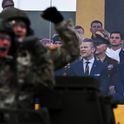Al Qaeda in the Arabian Peninsula (Aqap) asserted responsibility on Wednesday for last week's attack on the office of the satirical magazine Charlie Hebdo. The terrorist group claims that the offensive was years in the making, and that radical cleric Anwar al-Awlaki helped mastermind it.
Aqap also today praised the separate deadly siege last week at a kosher grocery store in Paris. The perpetrator of that attack, Amedy Coulibly, had pledged allegiance to the so-called Islamic State (IS) and his wife, Hayat Boumeddiene, a potential accomplice to that atrocity, is reported to have fled to Syria.
These claims by Aqap bring heightened focus to one of the most surprising features of the Paris terror attacks: the apparent links between several of the attackers and the competing jihadist groups of Aqap and IS. Questions still remain about whether the French terrorists were merely potentially inspired by Aqap and/or IS, or if either group played a substantial wider role in supporting the atrocities. It's not yet known whether the men killed as part of an anti-terror raid in Belgium yesterday were affiliated to either group, but they are said to have recently returned from Syria.
It was reported last week that at least one of the Paris terrorists, Said Kouachi, had links with Aqap. Media indicate that Kouachi met in Yemen in 2011 with Awlaki, who was subsequently assassinated in a US drone strike, and that Kouachi may also have received a period of terrorist training there and/or fought alongside Aqap.
One puzzle here is that al Qaeda and IS are actually in rivalry, rather than cooperation, with each other in the Middle East. IS, whose roots go back over a decade, was created in April 2013 from an al-Qaida affiliated organisation, Islamic State in Iraq (ISI).
ISI had, in turn, been formed from a group called al Qaeda in Iraq which was a major player in the insurgency against international forces following the toppling of Saddam Hussein's regime. Years later, ISI began its campaign against the Syrian regime of President Bashar al-Assad under the platform of the Nusra Front.
The origins of the disagreements between IS and al Qaeda stem, in large part, from ISI's decision in Spring 2013 to unify its fighters in Iraq and Syria under the banner of Islamic State in Iraq and the Levant (ISIS), the group which changed its name to IS in 2014. This merger of forces was opposed by al Qaeda's leader Ayman al-Zawahri, who replaced Osama bin Laden, who instead declared that IS should confine its activities to Iraq, especially after it was accused of brutal abuses of civilians and rival rebels in Syria.
Zawahri instead recognised the Nusra Front as the official al Qaeda affiliate in Syria and called for jihadist unity behind it in that country. That decision angered IS, and was taken before the latter's rise to much greater international prominence in 2014.
While IS is therefore technically a splinter group of al Qaeda, both sides have since disavowed each other. Indeed, IS accused al Qaeda last year of having "deviated from the correct path" and "divided the mujahedeen in every place."
IS's increased profile in 2014 was just one indicator that al Qaeda's influence had appeared to be ebbing. It is therefore unfortunate that the Paris attacks could provide a propaganda coup for the terrorist network that orchestrated 9/11 and other subsequent despicable acts across the world.
Another indication of al Qaeda's seemingly declining fortunes had been the fact that the network's central organisation has been significantly depleted. The assassination of numerous senior terrorist leaders has weakened it, as well as the fact that Zawahri lacks bin Laden's personal authority among supporters.
Another fundamental challenge for Zawahri is that the central al Qaeda leadership appears to be restricted largely in Pakistani tribal areas and borderlands. However, the wider network is becoming increasingly de-centralised and dispersed, and less able to be controlled by the centre.
Accompanying this dispersion and de-centralisation has been the shifting focus of al Qaeda groups and franchises, including Aqap, whose attention in recent years has generally been as much on "local" national or regional issues, rather than the grander international designs of bin Laden. In part, this probably reflects the greater difficulty of attacking key international targets, many of whose defences have hardened since 9/11.
As a result, the geographical focal points of al Qaeda activity have shifted. Terrorist nodes of growing importance, for instance, have grown in key African and Middle Eastern countries, including Yemen, where domestic political change since the so-called Arab Spring has allowed terrorists and other insurgents to secure a greater foothold.
Aqap was formed in 2009 as a merger between al Qaeda's Yemeni and Saudi branches. It has gained a growing foothold in Yemen taking advantage of political upheaval in the country that preceded and followed the departure of President Ali Abdullah Saleh in 2011 after some 33 years in power.
Aqap is believed by US officials to have undertaken a series of bomb plots against US targets. Perhaps most prominently, this included the foiled plan to bring down a Detroit-bound plane in 2009 using explosives hidden in a terrorist's underwear.
Reflecting the changed geographical risk pattern from al Qaeda, US forces have re-deployed themselves. For instance, the CIA has expanded its staff in Yemen, and enhanced its air bases in the Gulf. Last April, Washington launched a major drone attack in the region which killed a significant number of militants. This is believed to have included foreign fighters in an al Qaeda training camp in the remote mountainous area of Abyan.
The Paris attacks have once again shone the spotlight on al Qaeda and the group's core organisation will now try to extract sizeable propaganda value to help disguise its ebbing fortunes since bin Laden's demise. While central al Qaeda has diminished, much of the wider terrorist organisation has potency, including Aqap in Yemen. As western intelligence agencies seek to get to the bottom of the French atrocities, it is already clear that this dispersed and de-centralised al Qaeda apparatus will remain a significant, and potentially growing, source of concern for western governments for many years to come.
Al Qaeda and Islamic State: a deadly rivalry
Al Qaeda, whose influence has waned in recent years, will try to use last week's attacks in Paris as a propaganda coup
January 16, 2015

A video posted online shows slain hostage-taker Amedy Coulibaly, who shot a policewoman and four hostages at a kosher grocery in Paris, in front of an Islamic State banner ©AP Photo/Militant Video












